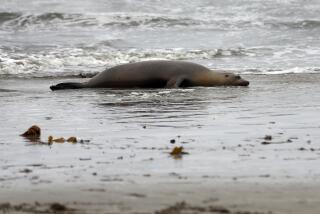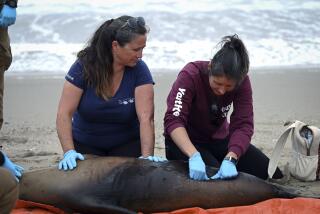More Harm From Alaska Oil Spill Found : Environment: A summary of studies on the effects of the Exxon Valdez incident reports greater and longer-lasting damage than earlier acknowledged.
Two years after the disastrous Exxon Valdez oil spill in Alaska, newly released scientific findings disclose far greater and longer-lasting environmental damage to fish and wildlife than previously acknowledged.
The 11-million-gallon spill of North Slope crude in Alaska’s Prince William Sound cut a broad swath through the ranks of marine mammals, fish, birds, such bottom-dwelling creatures as mussels and clams and land creatures such as bears and deer.
The newly released findings summarize 58 field studies carried out by state and federal agencies since the March, 1989, spill.
Disclosure of the findings, contained in a 19-page summary filed this week in federal court in Anchorage, came nearly a month after federal and state officials announced the terms of a proposed record $1.1-billion settlement with Exxon.
Despite the evidence of widespread devastation, Gov. Walter J. Hickel’s office said Wednesday that he and state Atty. Gen. Charles Cole still will press for acceptance of the settlement. Both Hickel and Cole were aware of the scientific reports when they announced the settlement terms last month in Washington, the governor’s spokesmen said.
“I don’t think it will have a particular negative effect on (accepting the settlement),” John Manly, Hickel’s deputy press secretary, said in a telephone interview. Alaska House Speaker Ben Grussendorf was reported as saying, however, that the damage assessment could make legislative approval more difficult.
In Anchorage, Exxon spokesman Joe Tucker, dismissing the summary as generalities, said Exxon would have no comment on what impact the data might have on the settlement.
There were calls, however, for the federal court to exercise caution in accepting the terms of the settlement in view of the new findings. The court, which can accept, reject or modify the settlement terms, is not expected to decide until at least next month.
In Washington, Rep. George Miller (D-Martinez), chairman of the House subcommittee on water, power and offshore energy resources, urged the federal court to move carefully in ruling on the offer.
“If this is, in fact, new evidence, then I think the court should slow this settlement down and take a very hard look at . . . whether this settlement is adequate,” Miller said by telephone Wednesday.
At the same time, Alaska’s legislative leaders were reacting to the disclosure Tuesday by Miller that a consortium of oil companies had secretly decided before the Exxon Valdez disaster not to respond to a spill in Prince William Sound.
In a letter to the Anchorage federal court on Wednesday, Alaska House Majority Leader Max Gruenberg Jr., who heads its oil-spill settlement committee, called the Miller disclosure “a significant new issue.”
“The allegations by Congressman Miller that Alyeska (the oil consortium) knowingly disregarded the requirements of its own contingency plan indicates there is a level of culpability on the part of both Exxon and Alyeska that could go well beyond criminally negligent conduct previously alleged against Exxon,” Gruenberg wrote. Alyeska has denied Miller’s charges.
According to the scientific data made public this week, between 350,000 and 390,000 birds may have died--nearly twice as many as early estimates. Oily substances continue to show up in the blood and fat samples of seals and otters. Eye tumors still are being found in Pacific herring. Almost two dozen killer whales are missing and believed dead. Deaths among several species of marine mammals, including seals and otters, are above normal.
In many of the species, the long-term impact on reproductive and other systems may not become apparent for years to come. The scientists said, however, that natural recovery has begun in many cases.
Until now, the findings have been a closely guarded secret because of a tangle of lawsuits involving the state and federal government, Exxon, and private citizens.
Some environmentalists were surprised that the government’s damage estimates were so high.
“It confirms a lot of our fears,” said Sue Libenson of the private, nonprofit Alaska Center for the Environment.
In New York, a senior attorney who has overseen the legal strategy for the private, nonprofit Natural Resources Defense Council on the spill, said the summary was no substitute for releasing the full studies.
According to the summary, between 3,500 and 5,000 of the 30,000 sea otters in Prince William Sound and the Gulf of Alaska were directly killed by the spill. Moreover, mussels in oiled areas, a key prey species for otters, have decreased markedly.
“The high number of prime-age sea otter carcasses found during 1990 indicates that the pattern of sea otter mortality in heavily oiled areas continues to be abnormal,” the summary said.
The decline in the harbor seal population, already evident before the spill, occurred at twice the rate in oiled areas after the spill. Lesions have been found in the brains of seals, and petroleum hydrocarbon levels in seals were five to six times higher a year after the spill.
Twenty-two killer whales known to be in groups before the spill were missing afterward and believed dead. Because their carcasses could not be examined, scientists could not directly attribute their deaths to the spill.
Preliminary analysis of brown bear fecal samples indicted that some of the animals were exposed to petroleum hydrocarbons. And, although there was no evidence that deer died as a result of the spill, they showed “slightly elevated” petroleum hydrocarbons.
Common and thick-billed murres were especially hard hit. In 1989 and 1990, colonies of the birds in spill areas lost 60% to 70% of their breeding population.
Of the 30,000 bald eagles in Alaska, an estimated 2,200 resided in Prince William Sound. Although only 144 were found dead, the actual number killed is likely to be far greater, the summary said.
Meanwhile, the impact on salmon and other fish will not be known until the salmon exposed to the oil as eggs and larvae return as adults this year. But among eggs deposited in oiled streams, there was 70% higher mortality in the summer of 1989 and a 50% greater rate in the summer of 1990.
WILDLIFE ENDANGERED BY THE SPILL
The toll of the 1989 crude oil spill from the Exxon Valdez in Alaska’s Prince William Sound continues to mount. A new summary of scientific studies carried out over two years reveals that in some cases the devastation of the environment is worse than previously believed. Among the latest findings:
SEA OTTERS
Estimated deaths: 3,500 to 5,500 out of a pre-spill population of 30,000 in Prince William Sound and Gulf of Alaska.
Carcasses found: 1,011.
Outlook: Sea otters are particularly vulnerable to spills; mortality in heavily oiled areas continues to be abnormal.
BIRDS
Estimated total deaths: 280,000 to 580,000; best guess at between 350,000 and 390,000.
Estimated deaths of murres: At least 172,000 breeding adults; these birds were among the hardest hit.
Estimated deaths of bald eagles: Several hundred.
Outlook: Murre breeding in oiled areas seriously disrupted.
KILLER WHALES
Estimated deaths: No direct link to the spill established, but 22 of the 182 killer whales living in area are thought to have perished.
Outlook: Survey continues this year.
HARBOR SEALS
Estimated deaths: At least 200; 19 carcasses found.
RIVER OTTERS
Estimated deaths: Unknown; erratic behavior observed in some.
SALMON
Outlook: No massive die-off of adults found after spill. But fish are most vulnerable to oil early in life. Scientists will check returning adult fish that were exposed to oil as eggs or larvae.
SOURCE: U.S. Department of Interior and Agriculture, National Oceanic and Atmospheric Administration
More to Read
Sign up for Essential California
The most important California stories and recommendations in your inbox every morning.
You may occasionally receive promotional content from the Los Angeles Times.










